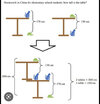Okay. Here’s what I gathered from Tony’s post.
The distance from the sensor to the edge of the M12 lens mount is measured at 8.79mm. Let’s assume this is correct even though the sensor has a small thickness.
Tony noted that he was able to achieve focus with the 8mm lens just at the edge of the mount. Barely engaged.
This means the distance from the sensor to the focal point on the lens is as follows:
8.79mm + distance from the focal point of the lens to the back of the lens (the space between the glass to the back of the lens)
The second part can be calculated as BFL minus MBF = 10.02mm - 6.80mm = 3.22mm
Therefore, for that specific lens, the distance from the sensor to the focal point of lens is 8.79mm + 3.22mm = 12.01mm. This number minus the BFL is how far he can engage the lens which would be 12.01 - 10.02 = 1.99mm
Since Tony was not able to achieve focus without modification to the mount, the 1.99mm he had available was probably reduced from the thickness of the sensor plus any little distance the lens was inside the mount but didn’t engage the thread. with all that accounted for, he was able to get “somewhat focus” but didn’t get the lens secured in the mount.
In short, both
BFL and
MBF plays a factor to figuring out which lens will work given the set parameters you have to work with (without having to modify anything else). You need both, not one or the other.
But wait there’s more! see simplified equation below.
On the case of the
6mm lens he initially used, using the same calculation:
BFL: 5.66mm
MBF: 5.01mm
Total Length: 8.79mm + (5.66mm - 5.01mm) = 9.44mm
maximum thread engagement to achieve focus = 9.44mm - BFL = 9.44mm - 5.66mm =
3.78mm. This one is much higher than the 8mm lens which guarantees focus since it allows you enough thread engagement to position the lens properly.
Simplified Equation:
Variables:
MTE = Maximum Thread Engagement
BFL = Back Focal Length
MBF = Mechanical Back Focal Lenth
8.79mm is the measured distance from the edge of the mount to the sensor.
MTE = 8.79mm + BFL - MBF - BFL
MTE = 8.79mm - MBF (eliminated BFL from equation).
This means BFL is no longer relevant!
So why was I looking for a lens with MBF less than 6mm? Because I want it to engage at least 2.79mm to achieve focus. Doesn’t matter what the BFL is.
This problem can be solved in similar fashion as this whereas in that particular case, the height of cat and turtle didn’t matter.

Does this mean a lens with a BFL of 100m or even 1000mm will work? Yes, as long as the MBF is less than 6mm so you can engage the threads. Then the lens will be positioned to the appropriate BFL.


